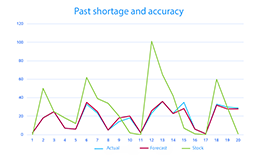What are the drawbacks of forecasting demand and inventory in stages?
Forecasting is the foundation of the planning process for any trading company. To efficiently manage inventory in a store or warehouse, it's crucial to accurately predict the expected demand over various timeframes, whether it's for a day, a week, a month, or an extended period.
The simplest way is to forecast demand using one of the available methods and, based on the obtained figure, order the required quantity of goods from suppliers.
However, since the world isn't perfect, demand forecasts aren't always accurate. Therefore, we need to have a safety stock for such instances. As a result, we now have two components for a future order.
While there are many methods for forecasting demand, safety stock is typically calculated using a standard normal distribution. Yet, only about 6% of items in a typical supermarket have a normal distribution. Using this method for the remaining products can result in inaccuracies because their demand patterns don't follow a normal distribution.
 Another pressing issue is how to forecast demand for a distribution center? An obvious solution seems to be, to sum up the adjusted sales history from all branches and base the demand forecast on that. However, tthis approach neglects the disparities in stock levels across different branches. Mere consolidation of remaining stock and total demand fails to account for scenarios where one branch might hold excess stock while another faces a deficit.
Another pressing issue is how to forecast demand for a distribution center? An obvious solution seems to be, to sum up the adjusted sales history from all branches and base the demand forecast on that. However, tthis approach neglects the disparities in stock levels across different branches. Mere consolidation of remaining stock and total demand fails to account for scenarios where one branch might hold excess stock while another faces a deficit.
It turns out that to calculate an order, we need to forecast two values: demand and product stock for a specific date. Both have random variables since guaranteeing high accuracy in a constantly changing market is challenging. Each of these components has its deviation. And the more components we have, the less accurate our final result will be, which in this case is the required order.
Moreover, we must consider data aggregation, sales variability, and the forecasting period. The smaller the data aggregation, the greater the variability of this data, making the forecast less precise. Similarly, the longer the forecasting period, the less accurate the forecast will be.
In summary, the process of ordering products from a supplier involves:
- Forecast the demand, which will inevitably have some margin of error, sometimes a significant one.
- Predict the necessary stock level by the product's arrival date, taking into account the remaining stock. This is based on the demand forecast, which already has inaccuracies. Additionally, there's an inherent margin of error in the stock forecast itself.
- Determine the safety stock. As we've established above, the calculation methods for this are far from perfect, meaning there will be a significant margin of error.
- Based on this data, calculate the order for suppliers, considering their constraints.
With such an approach, where multiple variables (each with its margin of error) need to be accounted for when placing an order, achieving a reasonably accurate forecast becomes very challenging. This remains true even if one employs advanced probabilistic forecasting methods.
It's also essential to note that when we forecast demand separately, we can't account for factors influencing stock levels. For instance, constraints due to product shelf life.
Another point to delve deeper into is ordering products for a distribution center to cater to branch needs.
What happens if we forecast demand separately? A common approach is to clean the sales history individually for each branch, forecast demand, and then sum it across branches. This results in a total demand. However, this method doesn't account for the remaining stock at each branch. If one or multiple branches have excessive stock, then the final order will lead to overstocking. Even if there's no surplus at the time of forecasting, it might appear later, say, in 3-4 days.
If, in addition to demand, we also separately consider the stock levels at the branches, suppose one branch has an excess of 100 products while another has a deficit of the same amount. If summed, it will net out to zero. It creates a situation where the existing stock meets the current demand, and no order is required. However, some branches will still face a deficit.

Why should we transition from step-by-step forecasting of demand and inventory directly to order forecasting?
Let's start with the fact that in real-world conditions, an order always has certain constraints: supply quantities, minimum order batch, minimum budget, and transportation capacity limits. If the minimum order batch is a multiple of 100 units, any forecasts we make within the range of 3-4 units become irrelevant in the final order.
It's crucial to understand that supply conditions aren't considered if we forecast inventory and demand separately. However, we can account for them if we directly forecast the order, making our planning more accurate.
Secondly, if a supplier charges for the cost of processing each order line, this can't be accounted for in separate inventory forecasting. This cost becomes an additional expense. For instance, it might be economical to maintain an inventory of 10 units. However, it's more cost-effective to order 100 units at once, as otherwise, orders would need to be placed frequently, and the processing cost would be high compared to the savings from maintaining a smaller inventory.
Now, let's consider how distribution centers, warehouses, and retail stores (collectively referred to as "branches") operate. They typically also generate orders. We can't calculate the optimal inventory for each branch and just sum up the obtained numbers. In this scenario, each branch will have its safety stock. We need the combined safety stock to be at the distribution center.
This means that each branch insures itself throughout the entire supply horizon, starting from the supplier, passing through intermediate distribution centers, and right up to itself. As a result, the final inventory stored on it significantly increases.
In the optimal model, a branch only ensures itself for the delivery time from the nearest distribution center. The insurance from the supplier to the distribution center is already at the distribution center itself.
However, if we calculate the demand forecast separately and then the inventory forecast, we might arrive at a figure, let's say 1000. From this number, it's impossible to determine how many goods are required (ordered) by each branch and how many by the distribution center.
The branch requirements simply get added to the overall necessary inventory, even though they could have been satisfied using the existing inventory at the distribution center. Alternatively, these needs could be met within the planned order for the distribution center or as part of a supplementary order for the safety stock at the distribution center.
This is why we need to transition from inventory planning to order calculation, i.e., the requirements of the branches. To understand how the stocks will be expended at the distribution center, the branches should model orders for the distribution center. Only then, with daily modeling of optimal orders made by branches, can we achieve an optimal inventory at the distribution center, which ultimately is formed from the needs of the branches and the distribution center itself.



